As someone who has a sweet tooth, pandan jelly is one of my all-time favorite desserts. The refreshing aroma of pandan combined with the sweet and chewy texture of the jelly never fails to put a smile on my face.
My personal experience with making Pandan Jelly was both fun and satisfying, and I am excited to share the process and tips with others who are interested in trying this delicious dessert. Whether I’m making it for myself or sharing it with friends and family, pandan jelly is a delicious and simple dessert that always brings happiness to the table.
What is pandan jelly?
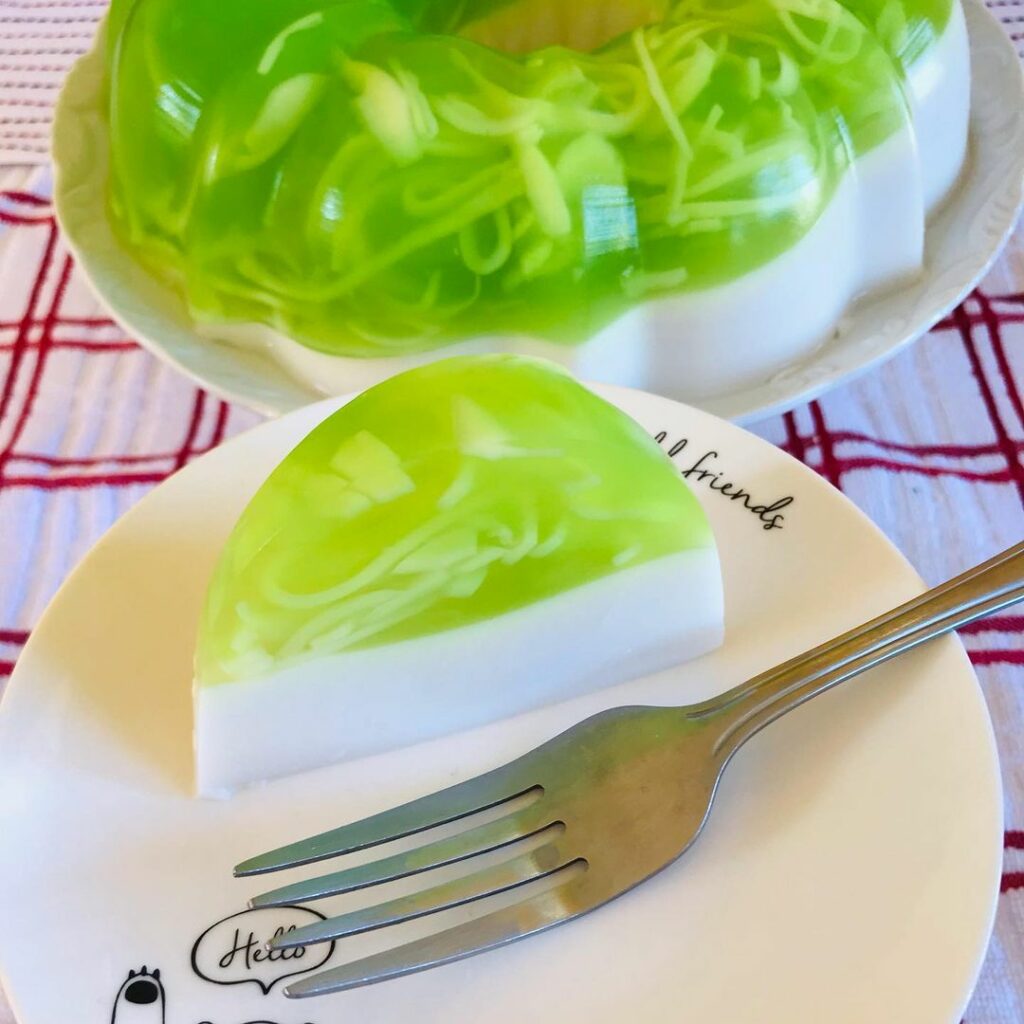
Pandan jelly origin is one of the popular Vietnamese desserts made from pandan leaves, water, sugar, and agar powder. Pandan leaves are known for their unique flavor and aroma, often described as nutty and floral.
The leaves are steeped in hot water to extract their essence, which is then mixed with sugar and agar powder to create a firm jelly. Vietnamese pandan jelly has been enjoyed for generations in countries such as Indonesia, Malaysia, and Thailand, and is gaining popularity worldwide due to its delicious taste and unique cultural heritage. You can add pandan leaf jelly to Che Thai or any other cold tea for extra texture.
Pandan jelly recipes
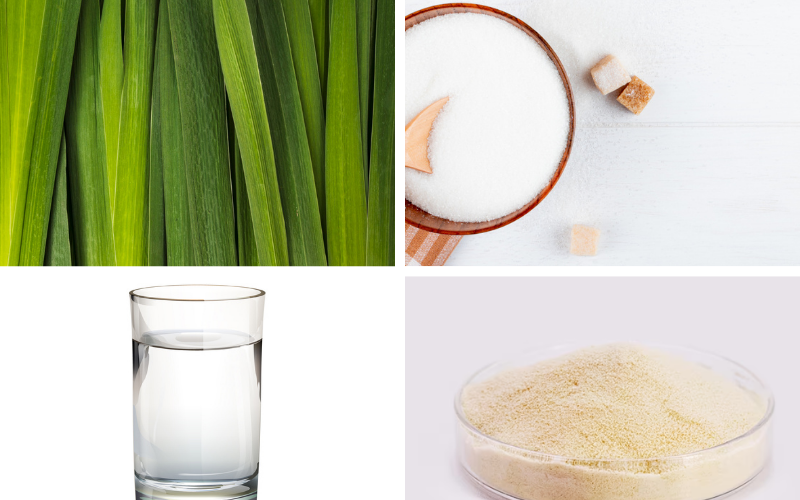
For best results, use fresh pandan leaves to extract the most flavor and aroma.
Cooking note
Classic pandan jellly recipe:
- Yield: 8 servings
- Prep Time: 10 minutes
- Cook Time: 20 minutes
- Total Time: 2 hours 30 minutes (including chilling time)
- Course: Dessert
- Cuisine: Southeast Asian
- Equipment: A saucepan, blender, and jelly mold.
Ingredients
- 10-12 pandan leaves, washed and tied into a knot
- 1 cup of sugar
- 1 packet (7 grams) of agar powder
- 4 cups of water
How to make pandan jelly?
Here is a step-by-step process for making pandan jelly:
- Rinse and cut 8-10 pandan leaves into small pieces.
- Place the pandan leaves in a pot with 4 cups of water and bring to a boil.
- Lower the heat and let the pandan leaves steep for 15–20 minutes.
- Strain the pandan water through a sieve and measure out 3 cups.
- Pour the pandan water back into the pot and add 1 cup of sugar and 2 tablespoons of agar powder.
- Bring the mixture to a boil, stirring constantly to ensure that the agar powder and sugar are completely dissolved.
- Add a few drops of green food coloring if desired.
- Pour the mixture into a jelly mold and let it cool to room temperature.
- Refrigerate for 1–2 hours until the jelly is set.
Tips for perfecting the texture and flavor of Vietnamese pandan jelly include adjusting the amount of sugar and agar powder to your preference. Adding too much agar powder can result in a rubbery texture, while too little can make the jelly too soft.
The ratio of pandan leaves to water can also affect the flavor of the jelly, so be sure to adjust according to your taste. Finally, using fresh pandan leaves instead of frozen ones can enhance the aroma and flavor of the jelly.
Common mistakes made when making pandan jelly
In the process of making pandan jelly to get the finished product, you will also make the following common mistakes, see and fix them to avoid these errors.
- Not measuring the ingredients accurately – Pandan jelly requires a precise ratio of pandan water, sugar, and agar powder. Using too much or too little of any ingredient can result in an uneven texture or inconsistent flavor.
- Not letting the pandan leaves steep long enough – Steeping the pandan leaves for at least 15–20 minutes is crucial to extract the maximum flavor from the leaves. Skipping this step or steeping for too short of a time can result in a weak flavor.
- Not stirring the mixture enough – When boiling the pandan water, sugar, and agar powder, it is important to stir constantly to ensure that everything dissolves completely. Otherwise, the mixture may not be set properly or have an uneven texture.
- Adding food coloring too late – If you are using food coloring to enhance the green color of the pandan jelly, be sure to add it before boiling the mixture. Adding it after the mixture has cooled can result in uneven coloring.
- Not refrigerating long enough – Pandan jelly needs to be refracted for at least 1–2 hours to set properly. Rushing this step can result in a soft and mushy texture.
Tips and tricks for making simple pandan jelly
Here are some tips and tricks for making simple pandan jelly:
- Use agar powder instead of gelatin – Agar powder sets faster and firmer than gelatin, making it perfect for pandan jelly.
- Use fresh pandan leaves – Fresh pandan leaves have a stronger aroma and flavor than frozen leaves, resulting in a more authentic and delicious Vietnamese pandan jelly.
- Use a fine-mesh strainer – Straining the pandan water through a fine-mesh strainer ensures that the jelly is smooth and free of any debris.
- Add sugar gradually – Adding sugar gradually instead of all at once can help ensure that the jelly is not overly sweet.
- Use a mold – Using a jelly mold gives the pandan jelly a professional and visually appealing look.
- Let it cool to room temperature before refrigerating – Letting the jelly cool to room temperature before refrigerating can help prevent condensation from forming on the surface of the jelly.
- Experiment with flavors – Pandan jelly can be flavored with other ingredients such as coconut milk, mango, or lychee for a unique and flavorful twist.
- Don’t overcook the pandan leaves – Overcooking the pandan leaves can result in a bitter taste and dull color, so be sure to remove them from the water after steeping for 15–20 minutes.
See more: Vietnamese Honeycomb Cake Recipe
How to store pandan jelly?
To store pandan jelly, place it in an airtight container and keep it in the refrigerator. Pandan jelly can be stored for up to 5-7 days in the refrigerator. It is important to cover the jelly to prevent it from absorbing any odors or flavors from other foods in the fridge.
If you need to store the jelly for longer, you can freeze it for up to 2-3 weekes. When freezing pandan jelly, it is best to cut it into small portions and wrap each portion in plastic wrap or aluminum foil to prevent freezer burn. When ready to serve, let the jelly thaw in the refrigerator overnight before consuming.
Table about nutrient facts of pandan jelly
Here is a table showing the nutrient facts of pandan jelly per 100 grams:
| Nutrient | Amount |
| CaloriesTotal Fat | 87 kcal0 g |
| Saturated Fat | 0 g |
| Trans Fat | 0 g |
| Cholesterol | 0 mg |
| Sodium | 50 mg |
| Total Carbohydrate | 21 g |
| Dietary Fiber | 0 g |
| Total Sugars | 21 g |
| Protein | 0 g |
Note: Nutrient values may vary depending on the recipe and specific ingredients used.
Is pandan jelly healthy?
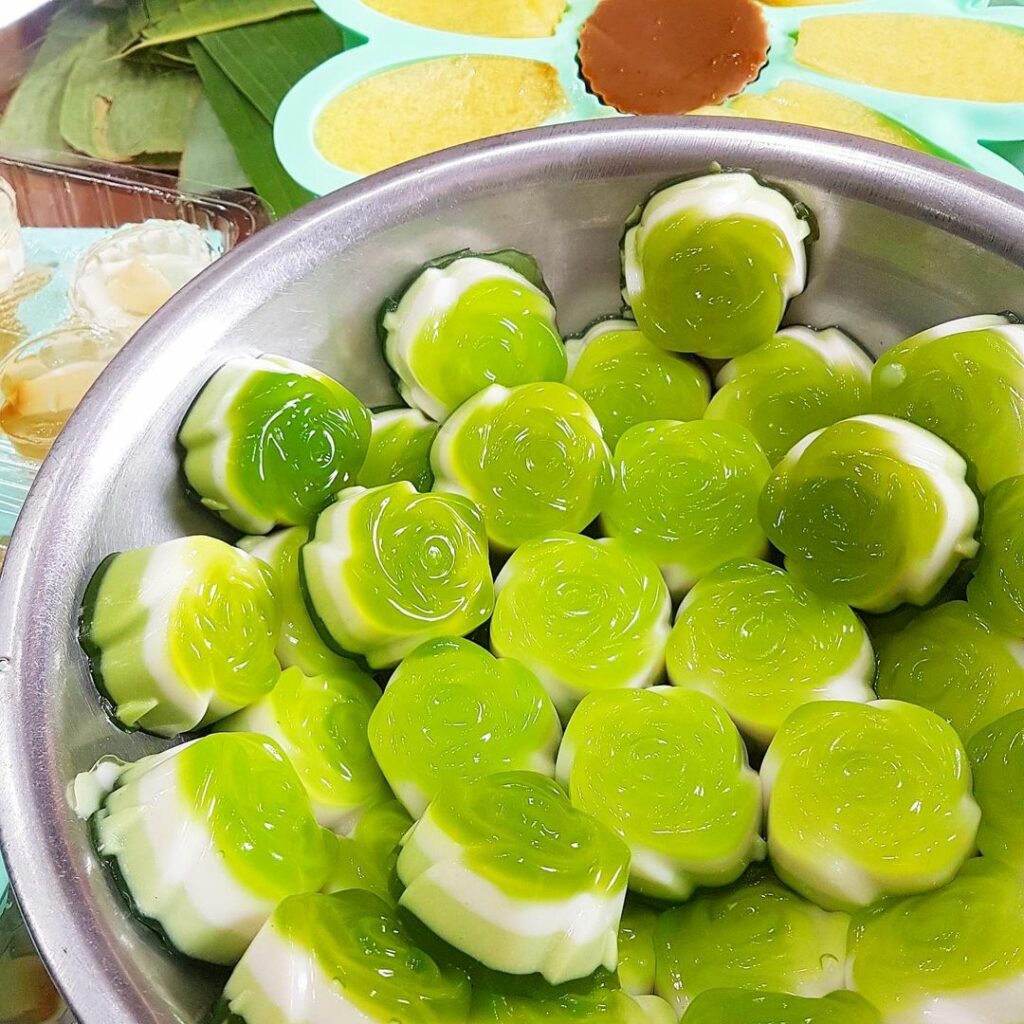
Vietnamese pandan jelly does not offer significant nutritional benefits, as it is superior, and made of sugar and agar powder. However, pandan leaves contain antioxidants and may have anti-inflammatory properties.
Pandan leaves are also a good source of vitamin C, which can help boost the immune system. Additionally, pandan jelly is a low-fat dessert option, making it a healthier alternative to other high-fat desserts.
So to answer the question “is pandan jelly healthy?” then the answer is already above, and you need to consider when eating pandan jelly. While pandan jelly does not offer significant health benefits, it can still be enjoyed in moderation as part of a balanced diet. The key is to be mindful of portion sizes and not rely on pandan jelly as a source of important nutrients.
See more: Banh Tieu Recipe
Potential risks and side effects of consuming pandan jelly
There will be cases where pandan jelly cannot be eaten, and they will have the following potential risks:
- Consuming pandan jelly in moderation is generally safe for most people. However, there are some potential risks and side effects to keep in mind:
- Allergies: Some people may be allergic to pandan leaves, which can cause symptoms such as itching, swelling, and difficulty breathing.
- Overconsumption of sugar: Pandan jelly is high in sugar, and consuming too much sugar can lead to health problems such as obesity, diabetes, and tooth decay.
- Overconsumption of agar powder: While agar powder is generally safe, consuming too much can cause digestive issues such as bloating, gas, and diarrhea.
- Contamination: If pandan jelly is not prepared or stored properly, it can become contaminated with bacteria or other harmful pathogens.
To reduce the risk of these potential side effects, it is important to consume pandan jelly in moderation, prepare it according to food safety guidelines, and be mindful of any allergies or sensitivities.
Variations of pandan pelly
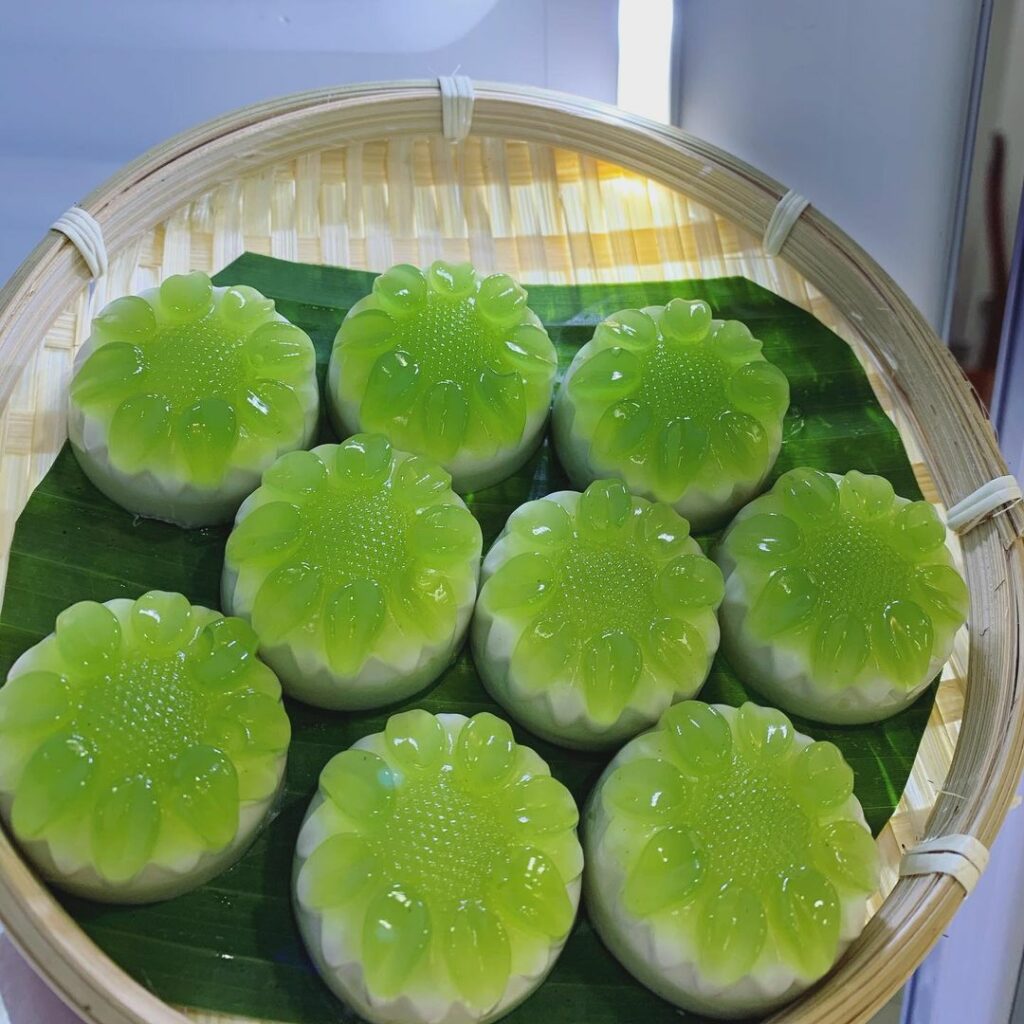
There are many variations of pandan jelly, including:
- Fruit pandan jelly: Adding fresh or canned fruit, such as mango or lychee, to the jelly mixture can add a burst of flavor and texture.
- Layered pandan jelly: Creating layers of different colored pandan jelly can add a visual appeal to the dessert.
- Pandan jelly with toppings: Adding toppings such as fruit, sweetened condensed milk, or whipped cream can enhance the flavor and texture of the jelly.
- Pandan jelly drinks: Using pandan jelly as a topping for drinks, such as milk tea or smoothies, can add a fun and unique twist to the beverage.
- Pandan jelly cake: Using pandan jelly as a layer in a cake can add a unique and flavorful element to the dessert.
These variations allow for creativity and experimentation with pandan jelly, making it a versatile dessert that can be enjoyed in many different ways.
What is the substitute material in pandan jelly?
There are a few possible substitutes for pandan leaves in pandan jelly:
- Pandan extract: If fresh or frozen pandan leaves are not available, pandan extract can be used as a substitute. However, pandan extract may not provide the same depth of flavor as fresh leaves.
- Vanilla extract: While it does not have the same nutty and floral flavor as pandan, vanilla extract can provide a similar sweetness and aroma to the jelly.
- Matcha powder: Adding matcha powder to the jelly mixture can provide a similar green color to pandan jelly, and also adds a unique flavor profile.
However, it is important to note that using substitutes may alter the taste and texture of the jelly, and may not result in the same authentic flavor as using pandan leaves.
Where to find pre-made pandan jelly?
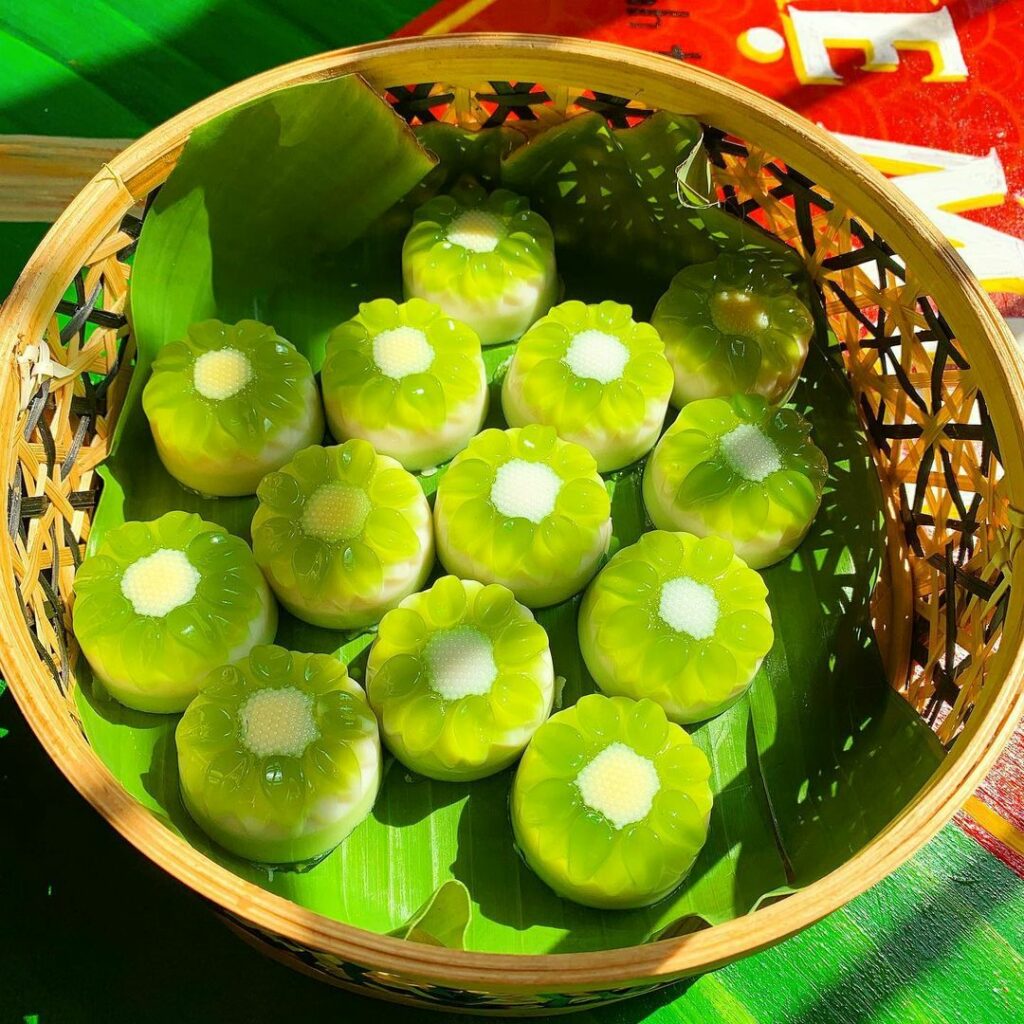
Pre-made pandan jelly can be found in both local markets and online stores. Here are some options:
- Local markets and grocery stores: Local Asian markets and grocery stores may carry pre-made pandan jelly in the refrigerated dessert section or in the aisle where Asian desserts are sold.
- Online stores and retailers: There are many online stores and retailers that offer pre-made pandan jelly, including Amazon, Walmart, and various Asian specialty food websites. Some online retailers may also offer frozen pandan jelly, which can be shipped to your door.
When purchasing pre-made pandan jelly, be sure to check the ingredients list and nutrition facts to ensure that it meets your dietary needs and preferences.
FAQs
Is pandan jelly vegan?
Pandan jelly can be vegan or non-vegan depending on the recipe and ingredients used. The traditional recipe for pandan jelly includes agar agar powder, which is derived from red algae and is vegan-friendly.
However, some recipes may include other ingredients such as milk or cream, which would make the pandan jelly non-vegan. It is important to check the ingredients list of a recipe or pre-made pandan jelly to determine whether it is vegan or not.
Is pandan jelly gluten-free?
Pandan jelly can be gluten-free, but it depends on the type of agar powder used. Agar powder is derived from seaweed and is naturally gluten-free.
However, some manufacturers may add gluten-containing ingredients as fillers or stabilizers. It is important to check the label of the agar powder or pre-made pandan jelly to ensure that it is gluten-free.
Additionally, if making pandan jelly from scratch, be sure to use gluten-free sweeteners and avoid any other ingredients that may contain gluten.
Can you freeze pandan jelly?
Yes, pandan jelly can be frozen for later consumption. To freeze pandan jelly, cut it into small portions and wrap each portion in plastic wrap or aluminum foil to prevent freezer burn. Store the wrapped portions in an airtight container or freezer bag and place them in the freezer.
Pandan jelly can be stored in the freezer for up to 2-3 weeks. When ready to serve, let the jelly thaw in the refrigerator overnight before consuming. It is important to note that freezing and thawing pandan jelly may affect its texture and taste, so it may not be as firm or fresh as freshly made pandan jelly.
Can you use frozen pandan leaves for pandan jelly?
Yes, you can use frozen pandan leaves for pandan jelly. Frozen pandan leaves can be found in many Asian grocery stores and are a convenient alternative to fresh pandan leaves, especially for those who do not have access to fresh pandan leaves.
When using frozen pandan leaves for pandan jelly, simply thaw the leaves at room temperature or in the refrigerator before using them in the recipe. It is important to note that the aroma and flavor of frozen pandan leaves may not be as strong as fresh pandan leaves, so you may need to use more leaves or steep them for a longer period of time to achieve the desired flavor and aroma.
Can you make pandan jelly without sugar?
It is possible to make pandan jelly without sugar, but the sweetness of the jelly may be affected. Sugar is a key ingredient in making pandan jelly as it helps to balance the flavor and sweetness of the dessert.
If you want to make pandan jelly without sugar, you can try using natural sweeteners such as honey or maple syrup. However, it is important to note that these substitutes may alter the texture and taste of the pandan jelly and may not provide the same level of sweetness as sugar.
Additionally, using natural sweeteners may make the pandan jelly non-vegan or non-gluten-free, depending on the specific substitute used.
What are the differences between pandan jelly and grass jelly?
Pandan jelly and grass jelly are two different types of Asian desserts that may look similar but have some key differences:
- Ingredients: Pandan jelly is typically made with pandan leaves, sugar, and agar agar powder, while grass jelly is made from boiled Chinese mesona, a type of mint family plant.
- Flavor and texture: Pandan jelly has a unique and distinct flavor that comes from the pandan leaves, with a slightly sweet and floral taste. It has a firm and gelatinous texture. Grass jelly, on the other hand, has a more subtle flavor that is slightly bitter and refreshing. It has a softer and smoother texture compared to pandan jelly.
- Origin: Pandan jelly is a dessert that is popular in Southeast Asian countries such as Indonesia, Malaysia, and the Philippines. Grass jelly, on the other hand, is a popular dessert in China, Taiwan, and other East Asian countries.
Can pandan jelly be made into a cake?
Yes, pandan jelly can be made into a cake or used as a cake topping. Pandan jelly cake is a popular dessert in Southeast Asia, and there are many recipes available that incorporate pandan jelly into the cake batter or use it as a topping.
To make a pandan jelly cake, you can use a basic cake recipe and add pandan flavoring or pandan extract to the batter. Once the cake has cooled, you can cut it into layers and spread pandan jelly between each layer.
You can also use pandan jelly as a cake topping by pouring it over the cake and letting it set in the refrigerator. Pandan jelly can add a unique flavor and texture to cakes, making it a fun and creative dessert option.
How do you prevent condensation from forming on top of pandan jelly?
Condensation can sometimes form on top of pandan jelly due to the difference in temperature between the chilled jelly and the warm air outside. To prevent condensation from forming on top of pandan jelly, you can try the following tips:
Let the jelly cool to room temperature before placing it in the refrigerator. This will help reduce the temperature difference and prevent condensation from forming.
Cover the jelly with plastic wrap or a lid while it sets in the refrigerator. This will help create a seal and prevent air from getting in and causing condensation.
Place a layer of paper towels or a clean cloth on top of the jelly before covering it. The paper towels will help absorb any excess moisture and prevent it from forming on the surface of the jelly.
Serve the jelly immediately after it has set in the refrigerator. If the jelly is left in the refrigerator for too long, condensation may start to form on the surface.
Conclusion
Finnaly , pandan jelly is a delicious and refreshing dessert that is enjoyed by many people. Its unique flavor and texture, combined with its vibrant green color, make it a popular dessert for both locals and tourists alike.
With its simple ingredients and easy preparation, it is a dessert that can be enjoyed by anyone, anywhere. Whether served on its own or with other sweet treats, pandan jelly is a dessert that is sure to satisfy your sweet tooth and leave you feeling refreshed.
Enjoy more desserts in Vietnam